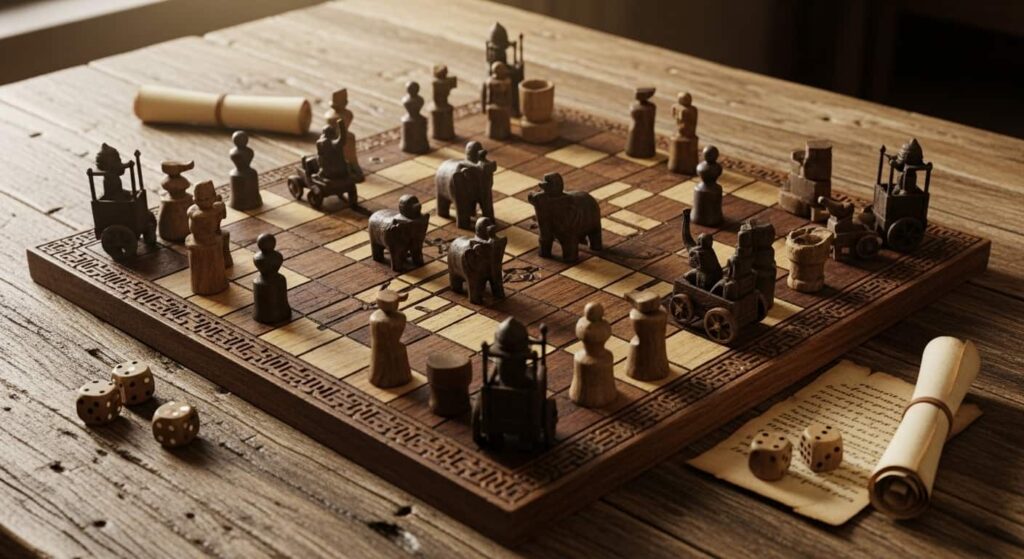Introduction
Board games have been a cherished part of human culture for centuries, bringing people together for fun, strategy, and learning. India, with its rich history and diverse traditions, has contributed significantly to the world of board games.
Many games we enjoy today have roots in ancient India, some dating back thousands of years. But when it comes to answering the question, which popular board game was invented in India?, several stand out, with Chaturanga, the ancestor of modern chess, being a leading contender.
This article explores the origins of popular board games invented in India, their historical significance, and their global impact, diving deep into why these games remain beloved today.
A Brief History of Board Games in India
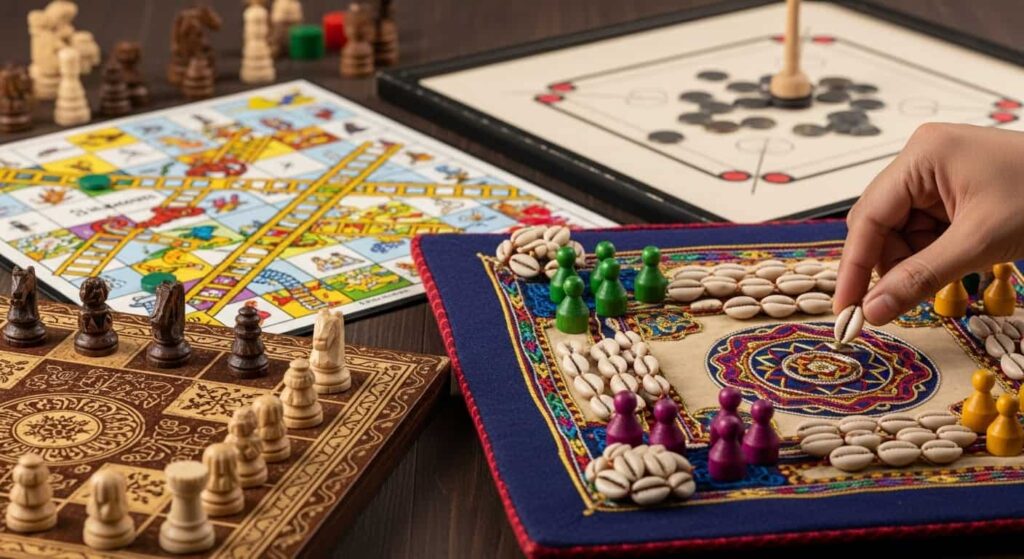
India’s board game legacy is as old as its civilization. Archaeological evidence from the Indus Valley Civilization (circa 3300–1300 BCE) suggests that people played games with dice and boards, possibly for entertainment and gambling.
These early games laid the foundation for more complex ones that emerged during the Gupta Empire (circa 320–550 CE) and beyond. Indian board games were not just about fun; they often carried cultural, strategic, or moral lessons, reflecting the society’s values and beliefs.
Games like Chaturanga, Pachisi, and Gyan Chaupar (Snakes and Ladders) were designed to teach strategy, morality, or even mathematics. These games were played by royalty, commoners, and even depicted in mythological stories involving gods like Shiva and Parvati. Let’s explore some of these iconic games to understand which popular board game was invented in India and how they shaped gaming culture worldwide.
Chaturanga: The Ancestor of Chess
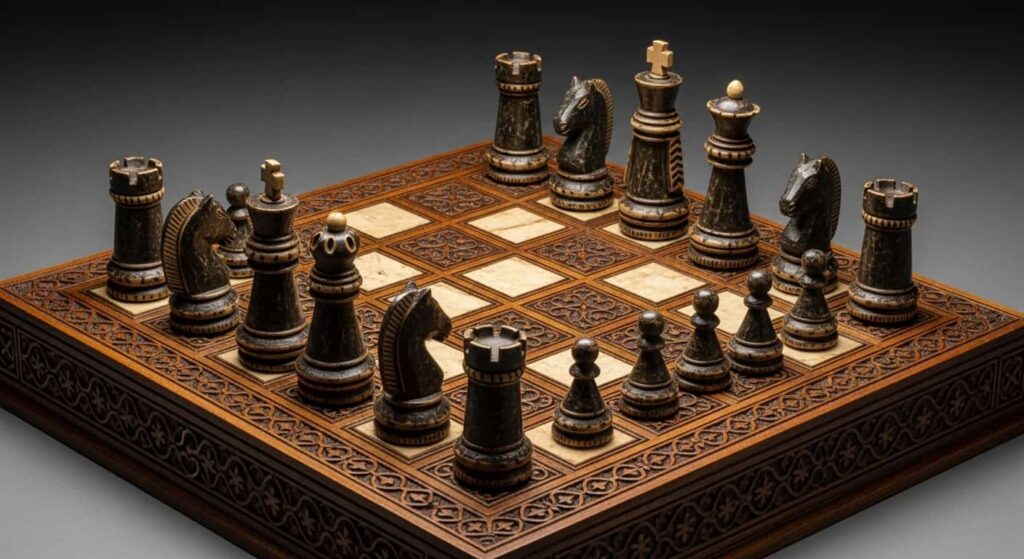
When discussing which popular board game was invented in India, Chaturanga often takes center stage. Believed to have originated during the Gupta Empire around the 6th century CE, Chaturanga is widely recognized as the predecessor of modern chess. Its name, derived from the Sanskrit word meaning “four parts,” refers to the four divisions of an ancient Indian army: infantry, cavalry, elephants, and chariots.
How Chaturanga Was Played
Chaturanga was played on an 8×8 uncheckered board, much like modern chess. The game involved four types of pieces, each representing a military unit:
- Infantry: Moved like pawns in chess.
- Cavalry: Similar to knights, with their unique L-shaped moves.
- Elephants: Comparable to modern bishops, though their movement varied in some versions.
- Chariots: Moved like rooks, covering rows and columns.
Unlike modern chess, Chaturanga sometimes used dice to determine moves, adding an element of chance. The objective was to checkmate the opponent’s king, a concept that carried over to modern chess. The game was not only a source of entertainment but also a tool to teach young princes about military strategy and tactics.
Global Spread of Chaturanga
Chaturanga’s influence spread beyond India, reaching Persia around 600 CE, where it evolved into Shatranj. The term “checkmate” comes from the Persian “Shah-Mat,” meaning “the king is dead.” From Persia, the game traveled to the Arab world and eventually Europe, where it became the modern chess we know today. This global journey underscores why Chaturanga is a top answer to which popular board game was invented in India.
Why Chaturanga Matters Today
Chess, with over 600 million players worldwide, owes its existence to Chaturanga. Its enduring popularity lies in its blend of strategy, foresight, and intellectual challenge. From casual players to grandmasters, chess continues to captivate, making Chaturanga’s legacy a cornerstone of global gaming culture.
Pachisi: The National Game of India
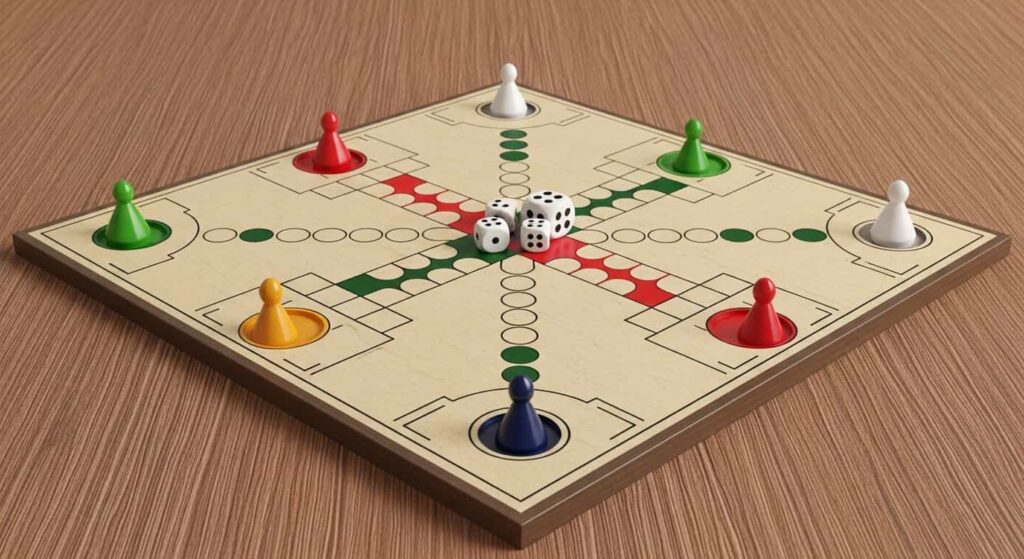
Another strong contender for which popular board game was invented in India is Pachisi, often called the “national game of India.” This cross-and-circle game, dating back to the Gupta Empire, is the ancestor of modern Ludo. Its name comes from the Hindi word “paccīs,” meaning “twenty-five,” the highest score achievable with the cowrie shells used as dice.
How Pachisi Works
Pachisi is played on a cross-shaped board, typically made of cloth or wood, with four arms extending from a central square. The game supports two to four players, often in teams, and involves moving beehive-shaped pieces based on the throw of six or seven cowrie shells. The number of shells landing with their openings upward determines the number of spaces a player moves.
Key features of Pachisi include:
- Capturing Opponent’s Pieces: Landing on an opponent’s piece sends it back to the starting point.
- Grace Throws: Throws of 10, 25, or 35 allow players to introduce new pieces or gain extra turns.
- Team Play: In four-player games, teams strategize to move all their pieces to the center first.
Pachisi’s blend of luck and strategy made it a favorite among all social classes, from commoners to emperors like Akbar, who reportedly played life-sized versions using palace staff as pieces.
Pachisi’s Modern Descendants
Pachisi’s influence is evident in games like Ludo, Parcheesi, and Sorry!. In 1896, the British patented a simplified version called Ludo, which became a household name worldwide. A depiction of Pachisi in the Ajanta Caves (circa 5th–6th century CE) highlights its popularity in medieval India, cementing its place in history.
Cultural Significance
Pachisi’s connection to Indian mythology is profound. Legends suggest Lord Rama played it during his exile, and the game’s cross-shaped board symbolizes the cosmic order. Its enduring appeal lies in its accessibility and the excitement of outwitting opponents, making it a strong candidate for which popular board game was invented in India.
Gyan Chaupar: The Roots of Snakes and Ladders

When exploring which popular board game was invented in India, Gyan Chaupar, also known as Moksha Patam or Parama Padam, deserves mention. This ancient game, believed to have been created by Jain monks around the early 1000s, is the precursor to Snakes and Ladders. Its purpose was to teach moral and spiritual lessons, particularly to children.
Gameplay and Moral Lessons
Gyan Chaupar was played on a numbered board with ladders representing virtues and snakes symbolizing vices. Players moved pieces based on dice rolls, climbing ladders for good deeds and sliding down snakes for moral failings. The goal was to reach Moksha (spiritual liberation), reflecting the Hindu concept of breaking free from the cycle of rebirth.
Key elements of Gyan Chaupar:
- More Snakes Than Ladders: The game had more snakes to emphasize the difficulty of achieving salvation.
- Moral Symbolism: Each square represented a specific virtue or vice, such as kindness or greed.
- Educational Tool: It taught players about karma and the consequences of actions.
The game’s spiritual depth made it popular among Hindu, Jain, and Sufi communities during the Bhakti period.
Global Adoption as Snakes and Ladders
In the 19th century, British colonizers simplified Gyan Chaupar, removing its moral symbolism and renaming it Snakes and Ladders. This version spread globally, becoming a staple in family game nights. Today, Snakes and Ladders is played by millions, with its simple rules appealing to all ages. Its Indian origins highlight its significance when answering which popular board game was invented in India.
Other Notable Indian Board Games
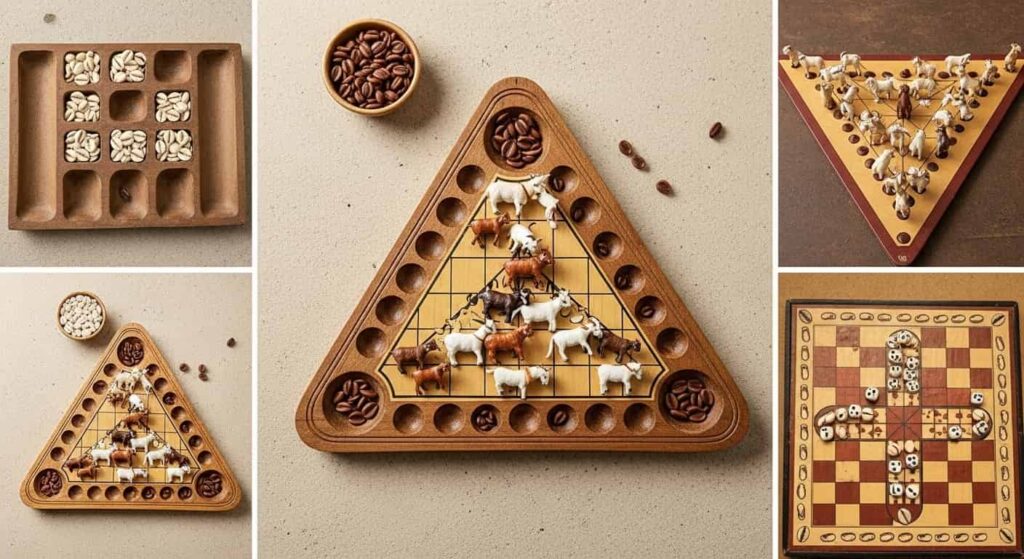
While Chaturanga, Pachisi, and Gyan Chaupar are the most famous, India gave birth to many other board games that deserve recognition. These games showcase the diversity and creativity of Indian gaming culture.
Pallankuzhi: A Game of Skill and Memory
Pallankuzhi, a traditional mancala game from South India, particularly Tamil Nadu, is played on a wooden board with 14 pits (seven per side) and 146 counters (seeds, shells, or stones). Players distribute counters across the pits, capturing them based on specific rules. The game, popular among women, sharpens memory and quick thinking. Its variations, like Kuzhipara in Malayalam and Ali Guli Mane in Kannada, are still played in rural areas.
Aadu Puli Attam: Goats and Tigers
Aadu Puli Attam, or Goats and Tigers, is a strategic two-player game from Tamil Nadu, also known as Puli-Meka in Telugu and Huli Ghatta in Kannada. Played on a triangular board, one player controls three tigers, while the other controls 15 goats. The tigers aim to “capture” goats by jumping over them, while the goats try to surround the tigers. This game, rooted in war-time strategy, remains popular in South India and even reached the Himalayas as Bagh Chal.
Chowka Bara: A Mathematical Challenge
Chowka Bara, a two- or four-player game from Karnataka, uses a 5×5 board and cowrie shells as dice. Players move pieces to the center square, combining strategy and chance. Mentioned in the Mahabharata, this game was designed to teach children mathematical skills and remains a cultural treasure in rural India.
Why Indian Board Games Endure
The question of which popular board game was invented in India reveals a rich tapestry of games that blend entertainment with cultural and educational value. These games have endured for several reasons:
- Cultural Resonance: Games like Pachisi and Gyan Chaupar are woven into Indian mythology and spirituality, connecting players to their heritage.
- Strategic Depth: Chaturanga and Aadu Puli Attam challenge the mind, appealing to players who enjoy intellectual pursuits.
- Universal Appeal: Their simple rules and engaging mechanics make them accessible to all ages and backgrounds.
- Global Influence: The spread of Chaturanga to chess, Pachisi to Ludo, and Gyan Chaupar to Snakes and Ladders shows their universal adaptability.
Statistics highlight their impact: chess is played by over 600 million people globally, and Ludo has seen a resurgence with over 100 million downloads of its mobile version on platforms like the Google Play Store. These numbers underscore the lasting legacy of Indian board games.
Reviving India’s Board Game Heritage
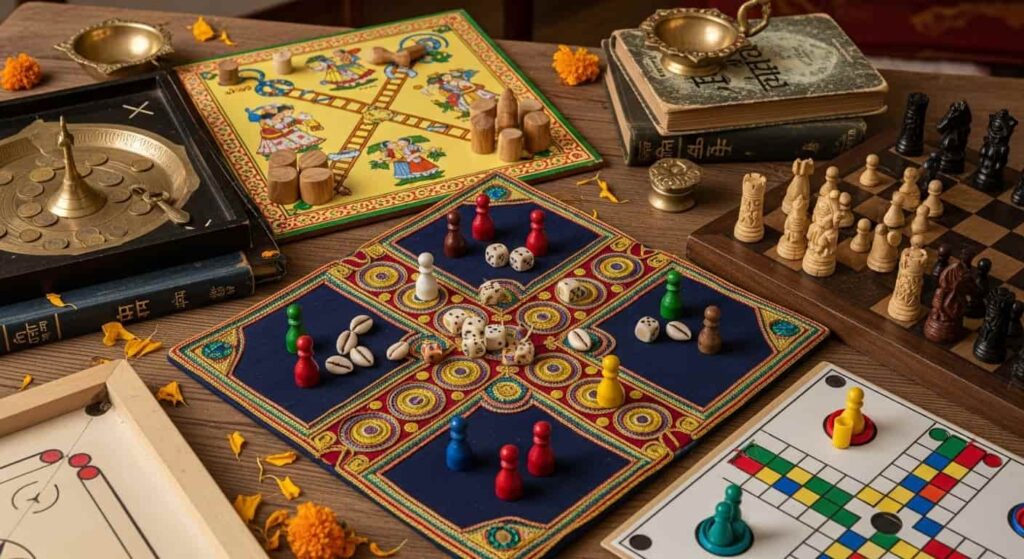
In today’s world of video games and digital entertainment, traditional Indian board games risk being forgotten. However, efforts are underway to revive them:
- Cultural Festivals: Events like the Kala Ghoda Arts Festival in Mumbai showcase traditional games like Pallankuzhi and Chowka Bara.
- Online Platforms: Apps like Zupee and Rush offer digital versions of Pachisi and other Indian games, making them accessible to younger generations.
- Educational Initiatives: Schools in Tamil Nadu and Karnataka incorporate games like Aadu Puli Attam to teach strategy and teamwork.
By playing these games, families can reconnect with India’s cultural roots while enjoying timeless fun. Whether it’s the strategic depth of Chaturanga or the moral lessons of Gyan Chaupar, these games offer something for everyone.
Conclusion
So, which popular board game was invented in India? The answer depends on perspective, but Chaturanga, Pachisi, and Gyan Chaupar stand out as the most influential, giving rise to chess, Ludo, and Snakes and Ladders, respectively. These games, born in ancient India, have transcended time and borders, shaping global gaming culture.
Their blend of strategy, luck, and moral teachings makes them more than just games—they’re a reflection of India’s rich heritage. Next time you sit down for a game of chess or Ludo, remember their Indian origins and the centuries of history behind every move.
